I am using the diamond-square algorithm to generate random terrain. It works fine except I get these large cone shapes either sticking out of or into the terrain. The problem seems to be that every now and then a point gets set either way too high or way too low.
Here is a picture of the problem

And it can be better seen when I set the smoothness really high

And here is my code -
private void CreateHeights()
{
if (cbUseLand.Checked == false)
return;
int
Size = Convert.ToInt32(System.Math.Pow(2, int.Parse(tbDetail.Text)) + 1),
SideLength = Size - 1,
d = 1025 / (Size - 1),
HalfSide;
Heights = new Point3D[Size, Size];
float
r = float.Parse(tbHeight.Text),
Roughness = float.Parse(RoughnessBox.Text);
//seeding all the points
for (int x = 0; x < Size; x++)
for (int y = 0; y < Size; y++)
Heights[x, y] = Make3DPoint(x * d, 740, y * d);
while (SideLength >= 2)
{
HalfSide = SideLength / 2;
for (int x = 0; x < Size - 1; x = x + SideLength)
{
for (int y = 0; y < Size - 1; y = y + SideLength)
{
Heights[x + HalfSide, y + HalfSide].y =
(Heights[x, y].y +
Heights[x + SideLength, y].y +
Heights[x, y + SideLength].y +
Heights[x + SideLength, y + SideLength].y) / 4 - r + ((float)(random.NextDouble() * r) * 2);
}
}
for (int x = 0; x < Size - 1; x = x + SideLength)
{
for (int y = 0; y < Size - 1; y = y + SideLength)
{
if (y != 0)
Heights[x + HalfSide, y].y = (Heights[x, y].y + Heights[x + SideLength, y].y + Heights[x + HalfSide, y + HalfSide].y + Heights[x + HalfSide, y - HalfSide].y) / 4 - r + ((float)(random.NextDouble() * r) * 2);
if (x != 0)
Heights[x, y + HalfSide].y = (Heights[x, y].y + Heights[x, y + SideLength].y + Heights[x + HalfSide, y + HalfSide].y + Heights[x - HalfSide, y + HalfSide].y) / 4 - r + ((float)(random.NextDouble() * r) * 2);
}
}
SideLength = SideLength / 2;
r = r / Roughness;
}
}
